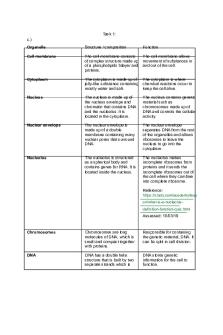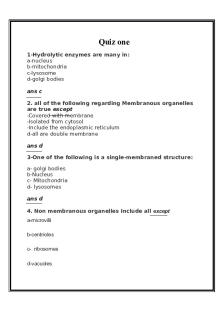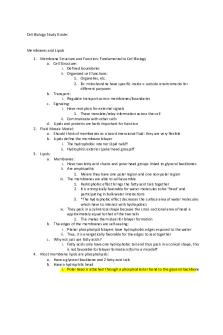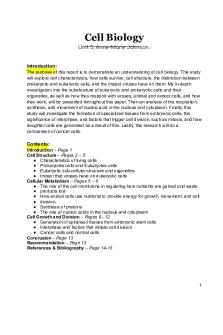Cells - Summary Cell Biology - MCAT prep PDF

| Title | Cells - Summary Cell Biology - MCAT prep |
|---|---|
| Course | Cell Biology |
| Institution | University of Alabama at Birmingham |
| Pages | 9 |
| File Size | 930.6 KB |
| File Type | |
| Total Downloads | 113 |
| Total Views | 178 |
Summary
Cell Biology course summary for Medical College Admission Test or MCAT...
Description
"Cells" Tuesday, January 9, 2018
10:07 AM
"Cell Membrane introduction"
"Phospholipid Structure"
• Cell membrane protects the cell from its environment • Cell membrane is semi-permeable because it controls what goes inside and outside the cell • Small nonpolar molecules can pass thru the cell as passive diffusion. For example, the most common typ of passive diffusion is gases such as oxygen and carbon dioxide. These pass thru the cell fast • A small polar molecule such as water and ethanol pass thru the cell slowly. • A large nonpolar molecule such as benzene pass thru the cell membrane slowly. • However, a large polar molecule such as glucose cannot pass thru our cellular membrane • A charged molecules such as chlorine and sodium ions are actually amino acids an cannot pass thru.
• The main building block of cell membrane are phospholipids. • Phospholipids consists of three main components: the phosphate head, the glycerol backbone, and the two fatty acid tails • The glycerol backbone is what holds the two fatty acids tails to the head. • The head of a phospholipid is hydrophilic or polar which means it interacts with water. • The tails of a phospholipid are hydrophobic or nonpolar which means it does not interact with water. • A molecule with an hydrophobic and hydrophilic structure, such as phospholipids, are called amphipathic. • A cell's environment consist mainly of water. Also the inside of the cell is manly water as well. Because of this fact, the cell membrane is structured as a phospholipid bilayer which allows the hydrophilic side interact with water. Fatty acid
"Cell Membrane Overview and Fluid Mosaic Model" • Phospholipids, Cholesterol and Proteins are what make up the cell membrane. • Phospholipid is the main component of cell membranes. • Cholesterol is also important in the cell. Since cholesterol is mainly composed of rings, it i a very stable molecule.
• Cholesterol is a buffer because it maintains the fluid of the cell membrane since it tends to insert itself within the phospholipids. As temperatures become lower, cholesterol helps to increase the fluidity, and as temperature become higher, cholesterol helps to decrease the fluidity of the cell membrane. • Proteins can take two major forms: integral protein/transmembrane protein or a protein tha can be located inside and outside the cellular membrane and peripheral proteins or a protei that can be located at the outside of the cellular membrane. Protein can be located in different regions; however the integral and peripheral proteins are the most common ones.
Glycerol
Phosphate
"Cell Membrane Proteins" • Integral proteins are located in the complete cellular membrane and are difficult to remove while peripheral proteins are located on the outsides of the cellular membran and can be removed without problem. An example of peripheral proteins are hormones. • Lipid bound proteins are inside the cellular membrane and do not interact with the outside nor the inside of the cell. • Integral proteins such as channel proteins can help stablish homeostasis (balance) by allowing outside ions inside the cell or allowing materials to leave the cell. It does not use energy and has to follow the concentration gradient. • Another important integral protein is the carrier protein which carries materials inside the cell. Unlike channel proteins, carrier proteins can go against concentration gradient and do need energy to perform. • Glycoproteins can exist in any of the above proteins as a signal proteins which is composed of sugar and proteins.
Inside Cell
"Cell Membrane Fluidity" Outside: Environment
• Protein act as receptors meaning they inform the cell about the outside environment. Transmembrane protein transport molecules inside and outside the cell. • Carbohydrates as glycoprotein and glycolipids bind to the phospholipids and to the cell membrane proteins for communication. For instance, cell communication.
"Membrane Dynamics" • How phospholipids move in the cell? • Uncatalyzed = no catalyst. 1. Phospholipids can move from the "extra" layer to the "intra" layer or vice versa; this type of movement is called transbilayer diffusion or flip-flop, and it is a slow movement
• Cell membrane contains membrane fluidity. • Membrane fluidity consists of: 1. Temperature 2. Cholesterol: serves as a buffer to aid the membrane when temp. changes 3. Unsaturation/Saturation Low Temperature = Low Fluidity High Temperature = High Fluidity Phospholipids will huddle closed together to The phospholipids will move more freely and form a crystalized state. Therefore, the have more space in between. phospholipids will have very low energy. Low concentration of cholesterol decreases High concentration of cholesterol increases fluidity fluidity At high temperatures, cholesterol will creases fluidity
At low temperatures cholesterol will increase fluidity
Saturated chains = Low Fluidity
Unsaturated chains = High Fluidity
"C ll J
ti
"
Membrane Dynamics • How phospholipids move in the cell? • Uncatalyzed = no catalyst. 1. Phospholipids can move from the "extra" layer to the "intra" layer or vice versa; this type of movement is called transbilayer diffusion or flip-flop, and it is a slow movement. 2. Also, phospholipids can move side by side thru lateral diffusion, and it is a fast movement. • Catalyzed = uses a catalyst such as protein. 1. Flippase: A fast movement. Proteins can aid phospholipids to move from the "extra" to the "intra" layers as transbilayer diffusion, but it needs ATP for this process. 2. Floppase: also uses ATP, and it moves phospholipids from the "intra" to the "extra" which is opposite from flippase. And again, it is also fast. 3. Scramblase: moves phospholipids from the outer leaflet to the inner leaflet and vice versa, and it does not required ATP, and again, since it is catalyzed, it is fast.
"Membrane Receptors" • Membrane receptors are integral proteins which allows our cell to communicate with the outside world. • Signal Transduction: ☺ Extra cellular signaling molecules consists of ions or molecules that binds to another chemical entity. These can also be called ligands (neurotransmitter, hormone, or a cell recognition molecule) These signals attaches to the extracellular space and change the chemistry of the cell. • Intracellular response: ☺ When the cell changes conformation due to signal transduction. This happens by the activation of intracellular signaling proteins. • Groups of membrane receptors: ☺ Ligand-gated ion channels ☺ G-protein coupled receptors ☺ Enzyme linked receptors
"G-Protein Coupled Receptors" • CPCRs = G-Protein Coupled Receptor • CPCRs are only found in eukaryotes, and they comprise of the largest known class of membrane receptors; hoverer each type of CPCRs is unique and it has an unique function • CPCRs can regulate the immune system growth, or sense of smell, of taste, visual, behavioral and our mood amongst many other functions. • They have 7 transmembrane alpha helices; that is why sometimes CPCRs is called the "7 transmembrane receptor" • G-proteins are specialized proteins that bind to GTP and GDP. They are small and contains a small subunit. • G-proteins are heterotrimeric or have three different subunits which are named : alpha, beta, and gamma. Only the alpha and gamma are attached to the cellular membrane and therefore are recognized as lipid anchors
• Inactivated G-Protein is attached to GDP in the alpha subunit • Activated G-Protein is attached to GTP • First, a molecule (ligand) with a complementary shape binds to GPCR. Then, GPCR undergoes a conformational change. Which, triggers a complex chain of events that will influence different cell functions. • As alpha swaps from GDP to GTP, betta will become detached from gamma. This step wil make the: alpha subunit and the beta-gamma dimer. • The alpha subunit regulates target proteins to produce sencond messages; for example, enzymes, ion channels. Note, as long as the ligand is attached to the CPCR, the alpha subunit will continue regulating target proteins. • This process will stop once GTP is hydrolyzed to GDP
• Examples of this process are: the fight or flight response because of adrenaline and epinephrine ligands
"How do Things Move Across a Cell Membrane?" • The bigger the cell the more nutrients are transported • Passive transport is when no energy is used for transport. For example, potassium leak channel (a facilitated diffusion which utilizes the help of a protein channel) maintains the potassium inside and outside the cell which should be an equal amount. On the opposite side Sodium channels keep large amounts of sodium outside the cell and small amounts inside. Also, diffusion moves solutes in space, osmosis moves water, filtration, and facilitated diffusion. • Active transports is when energy has been used. For example, a sodium potassium pump transfers sodium and potassium by breaking a molecule of ATP into ADP. Also, symport transportation move more than one molecule in the same direction; this is also known as secondary active transport. On the other hand, antiport moves molecules in and out both a th ti
creases fluidity
fluidity
Saturated chains = Low Fluidity
Unsaturated chains = High Fluidity
"Cell Junctions" • Tight junctions connects cells together. It is a complete fluid barrier meaning water and ions cannot pass thru. Tight junctions can be found in the bladder, intestines, or kidneys because water cannot be transferred in those organs since it holds fluid. • Desmosomes junctions connects separated cells together. These connections are attached to the cytoskeleton, and water and ions can pass thru freely. Desmosomes junctions can be found in ou skins and intestines. • Gap junctions connects cells in a tunnel in where ions and water can be transferred from one to another. This junction can be found within action potential cells or electrical coupling cell for example: cardiac muscle cells and neuron cells
"Ligand Gated Ion Channels" • Ligand gated ion channels are one type of major receptors • Ligand gated channels are transmembrane ion channel that open and close in response to a binding of a chemical messenger like a ligand • Common examples include electrically excitable cells like neurons because this sort of chann tend to react quickly. • Remember "transmembrane" refers to integral proteins that are located across the cellular membrane. This proteins are hollow inside and ions can pass in and out the cell; however, th need to be opened by ligands which will alter the entire conformation of the protein. • Note: the allosteric binding site of a ligand is typically in the extracellular space, but it can be found at the intracellular space as well. Also, the allosteric binding site is not located in the channel itself but on the outside of it.
"Enzyme Linked Receptors" • Enzyme linked receptors receives signals from the environment to instruct cell to do differen functions. In addition to that, they also function as enzymes. • Enzyme linked receptors are also known as catalytic receptors because they can speed up a biochemical reaction. • Enzyme linked receptors constitute of: • the extracellular portion which is the ligand bonding domain • The intracellular portion which is the enzymatic domain
• The most common enzyme linked receptor is known as receptor tyrosine kinases (RTK) which regulates cell growth, differentiation and survival. They can bind and respond to ligands such as growth factors. • The enzymatic function is that: RTK can transfer phosphorus from ATP fro intracellular proteins which activates them. • Kinase means that it contains the ability to transfer phosphorus molecules usually from a high energy substance like ATP • They have unique shape because tyrosine is on the intracellular enzymatic section. • RTK act in pairs: once the ligand bounds to the receptor, both RTKs associa together to form a cross-linked dimer. Then, a tyrosine from one RTK takes phosphorous out of its neighbor RTK and vice versa. Once phosphorylated, intracellular cytoplasmic section serves as docking platforms for different intracellular proteins involved in signal transduction. Note, for this process happen the proteins need to have SH2
"Diffusion and Osmosis" • Note, a mixture consists of a solvent and a solute. The solvent is the most predominant becau there is more of it, and the solute is subsidiary because there is less of it. For example, a coff cup consists of water as a solvent and coffee as a solute…if you like your coffee right. • Note, dissolved refers to when the solute is mix into the solvent. • Diffusion is the spreading of particles and molecules from a high concentration to a low concentration areas. • Hypertonic solution is a high concentration. • Hypotonic solution is a low concentration. • A semipermeable membrane allows water to diffuse into and out the cell. Molecules as sugar cannot diffuse in the cell. • The inside of the cell is hypertonic because it has a high concentration of solute. • The outside of the cell is hypotonic because it has a low concentration of solute.
facilitated diffusion. • Active transports is when energy has been used. For example, a sodium potassium pump transfers sodium and potassium by breaking a molecule of ATP into ADP. Also, symport transportation move more than one molecule in the same direction; this is also known as secondary active transport. On the other hand, antiport moves molecules in and out both a the same time. • Endocytosis is when large molecules such as amino acids (vesicles) can enter the cell by diffusion. • Exocytosis is when large molecules in vesicles diffuse out of the cell.
"Passive Transport by Facilitated Diffusion" • Passive transport has a total of four types of transport. The main one is facilitated diffusion • Facilitated diffusion occurs when a protein facilitates the diffusion of ions. Note, each protein is different and it contains a different shape for each ion. • Facilitates diffusion transport occurs: once an ion is attached to its complementary spot in the protein, the protein will flip from the outside to the inside of the membrane. • Remember these terms: an uncomfortable protein is a protein with an ion attached to it and when it is located at the wron side of the membrane while a confortable protein is a protei without an ion attached to it and in the right side of the membrane. In other words, it changes it conformation.
"Glomerular filtration in the nephron"
• Hypotonic solution is a low concentration. • A semipermeable membrane allows water to diffuse into and out the cell. Molecules as suga cannot diffuse in the cell. • The inside of the cell is hypertonic because it has a high concentration of solute. • The outside of the cell is hypotonic because it has a low concentration of solute. • If the cellular membrane was completely permeable, then the concentrations will be equal fr the outside and the inside, but it is not. • Because of the high concentration in the inside of the cell, water is more likely to enter than to exit. • Osmosis: Cell are interesting because they allow the diffusion of ions and molecules from a hypotonic solution to a hypertonic solution. This process makes the hypotonic a solute and th hypertonic a solvent. (Opposite from the general term)
"Membrane Potentials" • In this example shown below, the of the cell has a higher concentration of potassium than th outside of the cell. However, the net charge of the cell is neutral because there are other neg charge particles inside the cell as well.
• Unlike sodium, potassium will tend to move more outside the cell than inside the cell because th concentration gradient makes the potassium move outside. Unless, the cell reaches a negative ne charge instead of having a neutral charge. • As shown below, potassium starts exiting from the cell to the point in where the concentratio will reach equilibrium because more potassium is entering the cell at the same time. Also, th membrane potential follow this same path. • When the membrane potential reaches -92mV that will mean that it reached its equilibrium potential for K+.
• The nephron is the functional unit of filtration and collection in the kidney • The first part of the nephron is called the glomerulus; it receives branches that come off th renal artery, like afferent arterioles. Note, the branches going out from the glomerulus are efferent arterioles.
• To calculate the ratio of ions inside and outside a cell, you use the equation bellow. Note Calcium multiplies for 30.75 instead of 61.6 because its charge is +2:
• The glomerulus is where we take blood and turn it into filtrates and let the rest of the blood flow on. • The Bowman's capsule is a capsule that holds the glomerulus and collects the filtrate or the fluid.
"Permeability and Membrane Potentials" • In this example below, there are four cell and each one is permeable to one type of atom. • Note that positive ions leaving the cell make a negative membrane potential; for example, potassium. • Negative ions entering the cell make a negative membrane potential; for example calcium. • Positive ions entering the cell make a positive membrane potential; for example, sodium and calcium.
• How to calculate the total membrane potential of a cell? You need the average potential of e ion and their percentage. Note, most cells are like this because potassium is the most predominant ion:
"Sodium-potassium pump"
"Secondary active transport in the nephron" • Secondary active transport is a kind of transport that takes advantage of a concentration gradient; in this case, Na+ concentration differs inside and outside the cell. • Sodium-Potassium pumps are located around the apical membrane. So, there is a low concentration of Na+ inside the principal cell as well as the tubular fluid. • There is a few observations you want to make: • First, there is a symport in the apical membrane located at the peritubular fluid side; in there, Na+ is transported out of the cell and K+ is transported inside the cell. • Second, there is a cotransport in the apical membrane located at the tubular fluid side; in there, Na+ is transported inside the cell with the company of K+ and other nutrients like glucose and chlorine
• Cells have more positive charge outside of the membrane than inside of the membrane. So, this makes a potential gradient. • Sodium-potassium pump uses ATP, and it transport molecules and ions such as sodium and potassium from the inside of the membrane to the outside and vice versa. • The ratio between sodium and potassium are different, so in that way the pump pumps more positive charge ions on the outside and less in the inside.
"History and development of cell theory" • Colors represent each time period:
"Characteristics of Eukaryotic cells" • There are two major types of cells: prokaryotic cell and eukaryotic cells. • Eukaryotic cells are much larger and frequently found in multicellular organism, with the exception of a few. • Eukaryotic cells contain compartmentalization. This pretty much means that the cell is divided into different compartments. • Compartmentalization allows cells to have multiple functions. • Organelles is another name for each different compartment in a cell. You can think of them as different organs in a human body. • One of the most important organelles in a cell is the nucleus. The nucleus is a circular membrane-bound that contains all of the genetic material in the cell; unlike prokaryotes which has their genetic material and other substances floating around the cell. • Eukaryotes divide in a process called binary fission (MITOSIS). This process is pretty much duplicating the cell and then dividing it in the middle. • The nucleus contains all the DNA and transcribes the DNA into mRNA • The m...
Similar Free PDFs

Apoptosis - Summary Cell Biology
- 4 Pages

Cell biology summary notes website
- 33 Pages

Cell Systems- cells signalling
- 38 Pages

MCAT Biology - Endocrine System
- 1 Pages

Cell biology
- 3 Pages

162.101 Biology of Cells
- 35 Pages

Cell Biology Quiz CELL ORGANELLES
- 10 Pages

Cell Biology Study Guide
- 37 Pages

Cell Biology unit (5)
- 14 Pages

Cell Biology Syllabus 2019
- 5 Pages
Popular Institutions
- Tinajero National High School - Annex
- Politeknik Caltex Riau
- Yokohama City University
- SGT University
- University of Al-Qadisiyah
- Divine Word College of Vigan
- Techniek College Rotterdam
- Universidade de Santiago
- Universiti Teknologi MARA Cawangan Johor Kampus Pasir Gudang
- Poltekkes Kemenkes Yogyakarta
- Baguio City National High School
- Colegio san marcos
- preparatoria uno
- Centro de Bachillerato Tecnológico Industrial y de Servicios No. 107
- Dalian Maritime University
- Quang Trung Secondary School
- Colegio Tecnológico en Informática
- Corporación Regional de Educación Superior
- Grupo CEDVA
- Dar Al Uloom University
- Centro de Estudios Preuniversitarios de la Universidad Nacional de Ingeniería
- 上智大学
- Aakash International School, Nuna Majara
- San Felipe Neri Catholic School
- Kang Chiao International School - New Taipei City
- Misamis Occidental National High School
- Institución Educativa Escuela Normal Juan Ladrilleros
- Kolehiyo ng Pantukan
- Batanes State College
- Instituto Continental
- Sekolah Menengah Kejuruan Kesehatan Kaltara (Tarakan)
- Colegio de La Inmaculada Concepcion - Cebu





